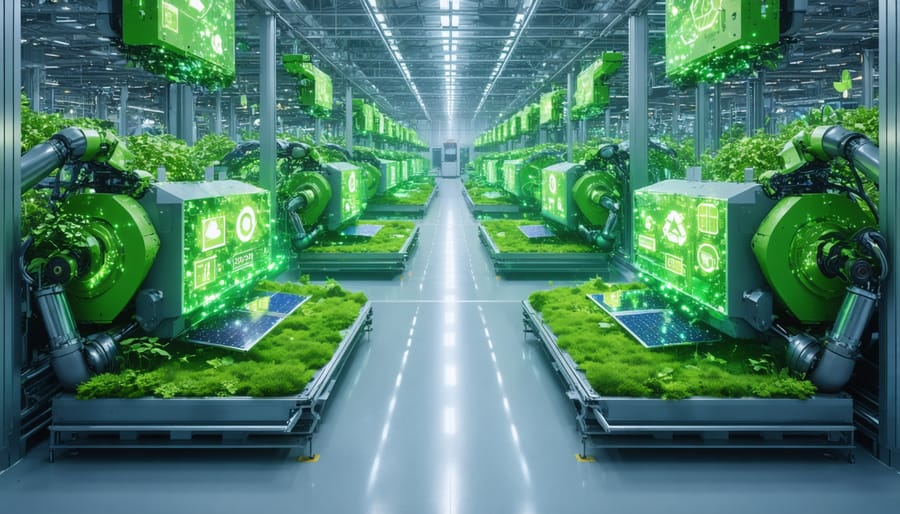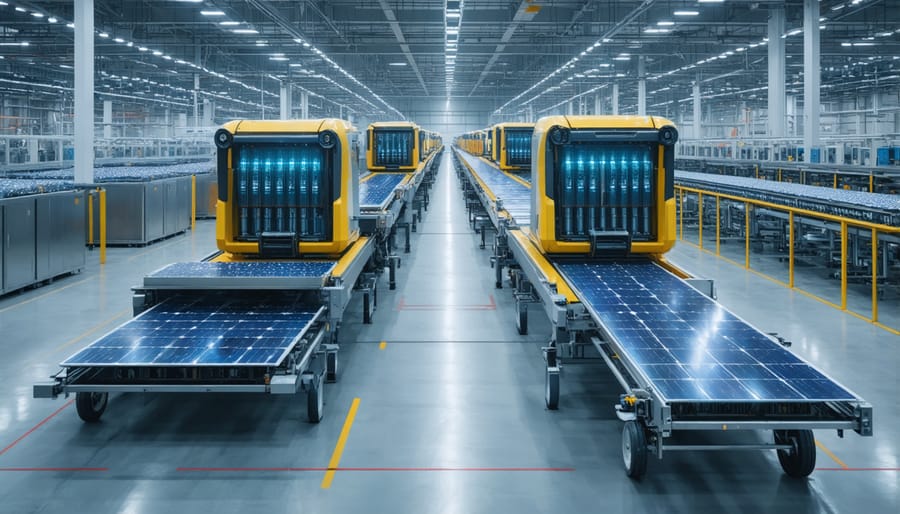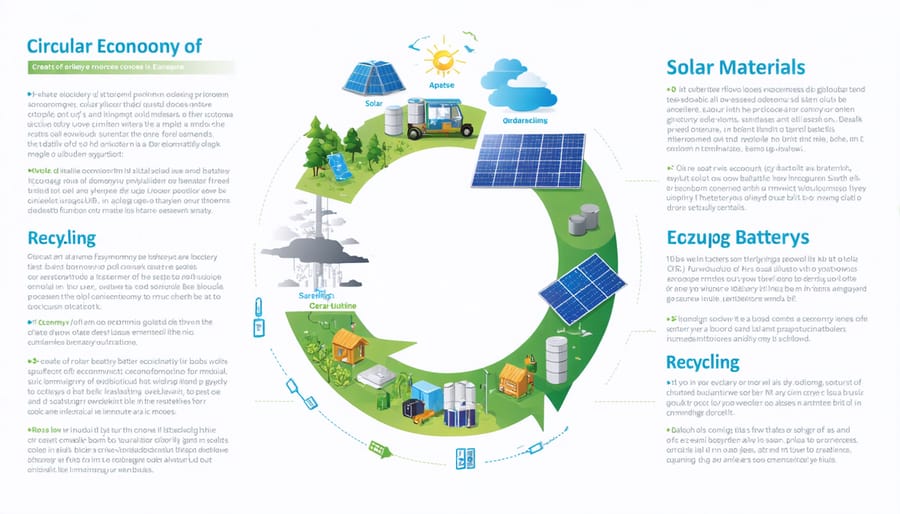Smart Solar Battery Recycling: How Advanced Systems Are Revolutionizing Sustainability

Advanced recycling systems represent a pivotal technological leap in our journey towards a circular economy, transforming how we handle end-of-life materials from solar installations to complex industrial waste. European innovation has pioneered sophisticated automated sorting mechanisms, molecular recycling processes, and AI-driven material recovery systems that achieve recovery rates exceeding 95% for critical components.
Today’s advanced recycling facilities combine robotics, artificial intelligence, and chemical processing to break down complex materials into their fundamental building blocks. These systems not only recover valuable metals and semiconductors from solar panels and batteries but also dramatically reduce the environmental impact of waste management operations. In Germany alone, these technologies have enabled the recovery of over 1,000 tonnes of silver and silicon from decommissioned solar installations annually.
The integration of IoT sensors and real-time analytics has revolutionized material identification and separation processes, ensuring maximum resource recovery while minimizing energy consumption. This technological convergence represents a crucial step toward achieving the EU’s ambitious 2030 sustainability targets and establishing a truly circular economy in the renewable energy sector.
This next generation of recycling infrastructure demonstrates how innovative engineering can transform environmental challenges into economic opportunities while safeguarding our planet’s resources for future generations.
The Evolution of Solar Battery Recycling Technology
Traditional vs. Advanced Recycling Methods
While traditional battery recycling methods rely primarily on mechanical and pyrometallurgical processes, advanced recycling systems incorporate sophisticated technologies that significantly improve recovery rates and environmental outcomes. Modern methods utilize automated sorting systems, advanced chemical extraction processes, and artificial intelligence to optimize material separation.
Contemporary recycling facilities employ hydrometallurgical techniques that can recover up to 95% of battery materials, compared to the 50-60% recovery rate of conventional methods. These advanced systems also consume less energy and produce fewer emissions during the recycling process. Smart sensors and machine learning algorithms ensure precise material identification, reducing contamination and improving the quality of recovered materials.
Another key advancement is the introduction of closed-loop systems that minimize waste and maximize resource efficiency. These systems integrate seamlessly with manufacturing processes, enabling direct material reuse and reducing the need for virgin resources. The shift towards these innovative methods aligns with European sustainability goals and circular economy principles, setting new standards for responsible resource management.

Key Technological Breakthroughs
Recent innovations in solar battery recycling have revolutionized how we manage end-of-life energy storage systems. Advanced automated sorting systems now employ artificial intelligence and machine learning to identify different battery components with unprecedented accuracy. These systems can process up to 1,200 batteries per hour, significantly improving efficiency compared to manual methods.
A breakthrough in hydrometallurgical processing has enabled the recovery of up to 95% of critical materials, including lithium, cobalt, and nickel. This process uses environmentally friendly water-based solutions rather than traditional energy-intensive thermal methods. European research facilities have developed novel chemical separation techniques that preserve the molecular structure of recovered materials, making them immediately suitable for manufacturing new batteries.
Vacuum thermal recycling, another significant innovation, allows for the safe extraction of electrolytes while preventing harmful emissions. This technology, pioneered by European engineering firms, reduces energy consumption by 40% compared to conventional recycling methods. Additionally, new modular recycling units have made it possible for smaller facilities to process batteries locally, reducing transportation costs and environmental impact while supporting regional circular economy initiatives.
Advanced Recycling Systems in Action
Automated Sorting and Classification
Modern recycling facilities are increasingly employing artificial intelligence and advanced robotics to revolutionize sorting and classification processes. These systems use sophisticated sensors, cameras, and machine learning algorithms to identify and separate different materials with unprecedented accuracy and speed.
At the heart of these systems are AI-powered optical sorters that can distinguish between various types of plastics, metals, and other recyclables based on their physical and chemical properties. High-resolution cameras capture thousands of images per second, while near-infrared (NIR) sensors analyze material composition in real-time. The AI systems continuously learn and adapt, improving their recognition capabilities over time.
Robotic arms equipped with precise grippers and suction mechanisms work in conjunction with AI systems to physically separate materials. These robots can perform up to 70 picks per minute, significantly outpacing manual sorting methods while maintaining consistent accuracy levels above 95%. This automation not only increases throughput but also creates safer working conditions by reducing human exposure to potentially hazardous materials.
In European facilities, these systems are particularly effective at handling complex waste streams, including solar panel components and electronic waste. The technology can identify and sort materials as specific as different grades of silicon and rare earth metals, ensuring maximum resource recovery and supporting circular economy initiatives.
The implementation of these automated systems has led to significant improvements in recycling rates and material purity, making downstream processing more efficient and economically viable.

Chemical Recovery Processes
Modern chemical recovery processes represent a significant advancement in solar battery recycling, utilizing sophisticated extraction methods to reclaim valuable materials. Through advanced material recovery techniques, these systems can extract up to 95% of critical elements like lithium, cobalt, and nickel from end-of-life batteries.
The process typically begins with hydrometallurgical treatment, where batteries are submerged in specialized chemical solutions that selectively dissolve target metals. This is followed by advanced separation processes, including solvent extraction and electrowinning, which isolate individual materials with exceptional purity levels.
European facilities have pioneered innovative precipitation methods that minimize chemical waste while maximizing recovery rates. These processes employ environmentally responsible reagents and closed-loop systems that recycle processing chemicals, significantly reducing environmental impact.
Recent developments include automated sorting systems that use artificial intelligence to identify battery chemistry types, enabling more precise treatment protocols. This technology, combined with advanced leaching processes, has increased recovery efficiency while reducing energy consumption and processing time.
The recovered materials meet stringent quality standards for reuse in new battery production, supporting circular economy principles and reducing dependence on raw material extraction. This sustainable approach has become increasingly crucial as Europe continues to lead in environmental stewardship and resource conservation.
Material Purification Technologies
Modern recycling systems employ sophisticated purification technologies to transform mixed waste materials into high-quality recycled resources. The process begins with advanced sorting mechanisms that utilize artificial intelligence and machine learning to identify and separate different materials with unprecedented accuracy.
One of the most significant innovations is the implementation of optical sorting technology, which uses near-infrared (NIR) sensors to distinguish between various types of plastics and other materials. This technology enables the separation of materials based on their chemical composition, ensuring higher purity levels in the final recycled product.
Chemical purification processes play a crucial role in removing contaminants and additives. Advanced solvent-based purification techniques can separate polymers from complex waste streams, while innovative filtration systems remove microscopic impurities. Decontamination through super-critical CO2 treatment has emerged as an environmentally friendly method for achieving food-grade recycled materials.
Mechanical recycling has also evolved significantly, with new-generation washing systems that use biodegradable detergents and closed-loop water systems. These systems effectively remove adhesives, labels, and other surface contaminants while minimizing environmental impact.
Quality control systems utilizing X-ray fluorescence and spectroscopic analysis ensure that purified materials meet strict European standards for recycled content. This comprehensive approach to material purification has enabled the production of high-quality recycled materials that can effectively compete with virgin materials in various industrial applications.
Environmental and Economic Benefits
Resource Conservation
Advanced recycling systems significantly reduce the demand for raw materials by creating efficient closed-loop material cycles. Through sophisticated sorting and processing technologies, these systems can recover up to 95% of valuable materials from end-of-life solar panels and batteries, effectively diminishing the need for virgin resource extraction.
The process begins with automated separation systems that precisely identify and sort different materials, including precious metals, silicon, and rare earth elements. These recovered materials maintain their original quality, making them suitable for manufacturing new solar components. For instance, recycled silicon from solar panels can be repurposed into new photovoltaic cells, while recovered metals like silver and copper return to the production chain with minimal quality loss.
This resource conservation approach delivers substantial environmental benefits. Every tonne of recycled materials prevents approximately 2.5 tonnes of CO2 emissions compared to raw material extraction. Moreover, advanced recycling reduces water consumption and habitat disruption associated with mining operations.
European industries have embraced these systems, implementing sophisticated material recovery facilities that serve as regional hubs for sustainable resource management. The adoption of advanced recycling technologies has created a robust circular economy, where materials continuously cycle through the supply chain, reducing Europe’s dependence on imported raw materials while supporting local manufacturing capabilities.
Cost-Effectiveness Analysis
Modern recycling systems demonstrate compelling economic benefits of recycling through significant cost reductions and resource optimization. Initial investment in advanced recycling infrastructure typically yields returns within 3-5 years through reduced waste management costs, recovered material value, and decreased regulatory compliance expenses.
Analysis shows that automated sorting systems can process materials up to 60% faster than traditional methods while reducing labor costs by 40%. These systems achieve material recovery rates of up to 95%, substantially higher than conventional recycling approaches, translating to approximately €200-300 in recovered value per tonne of processed material.
European facilities implementing advanced recycling technologies report average operational cost savings of 25-35% compared to traditional recycling methods. The integration of AI-driven sorting mechanisms and robotic handling systems has demonstrated particular cost-effectiveness in processing complex waste streams, with maintenance costs typically 20% lower than manual systems.
Energy efficiency improvements in modern recycling facilities contribute to additional savings, with new systems consuming 30-40% less energy per tonne of processed material. Furthermore, the high-quality output from advanced systems commands premium prices in secondary material markets, enhancing the overall economic viability of recycling operations.

European Leadership in Battery Recycling
Europe has emerged as a global leader in solar battery recycling technology, driven by ambitious sustainability goals and innovative research initiatives. The continent’s commitment to circular economy initiatives has resulted in groundbreaking developments in recycling processes and infrastructure.
Leading European research institutions and companies have developed advanced hydrometallurgical processes that can recover up to 95% of valuable materials from end-of-life solar batteries. These sophisticated systems employ automated sorting mechanisms, precision dismantling robots, and advanced material separation techniques to ensure maximum resource recovery while minimizing environmental impact.
Several key innovations distinguish European recycling facilities. First, the implementation of AI-powered sorting systems has dramatically improved the accuracy and efficiency of battery component separation. Second, novel chemical processes have been developed to extract and purify precious metals like lithium, cobalt, and nickel with unprecedented precision. Third, the integration of renewable energy sources in recycling facilities has significantly reduced the carbon footprint of recycling operations.
The success of European recycling programs is further supported by comprehensive collection networks and standardized protocols across member states. This coordinated approach has enabled the creation of efficient reverse logistics systems, ensuring that end-of-life batteries are properly collected and processed.
Notable achievements include the development of closed-loop recycling systems in Germany and France, where recovered materials are directly reintegrated into new battery production. These systems demonstrate the practical viability of sustainable battery manufacturing and set new benchmarks for resource efficiency.
European leadership in this sector continues to drive global innovation, with many countries now looking to adopt similar technologies and practices. This pioneering work not only supports environmental sustainability but also strengthens Europe’s position in the growing clean energy economy.
Advanced recycling systems represent a crucial stepping stone toward a more sustainable future in Europe’s renewable energy sector. As we’ve explored throughout this article, these innovative solutions are transforming how we handle end-of-life solar components, particularly batteries and panels, while significantly reducing environmental impact and maximizing resource recovery.
The integration of artificial intelligence, automated sorting technologies, and advanced material recovery processes has revolutionized recycling efficiency, achieving recovery rates of up to 95% for certain materials. This technological progress, combined with strengthening regulatory frameworks across Europe, positions our continent as a global leader in sustainable waste management practices.
Looking ahead, the future of advanced recycling systems appears promising. Ongoing research and development efforts focus on improving process efficiency, reducing energy consumption, and developing new technologies for handling emerging materials in solar components. The growing emphasis on circular economy principles and extended producer responsibility will likely drive further innovations in this field.
For European businesses and homeowners, embracing these advanced recycling systems isn’t just an environmental choice – it’s an economic imperative. As recycling technologies continue to evolve, we can expect even more efficient recovery processes, lower operational costs, and enhanced material quality, ultimately contributing to a more sustainable and resource-efficient solar energy sector.
Our commitment to advanced recycling systems today will shape the renewable energy landscape of tomorrow, ensuring a cleaner, more sustainable future for generations to come.
Leave a Reply